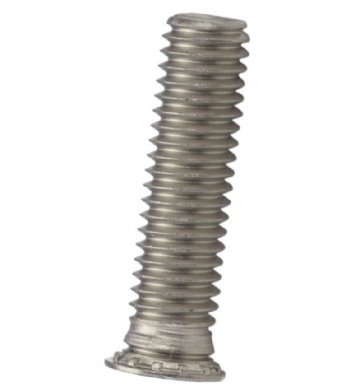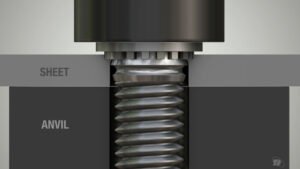

ss-clinch-stud-stainless-steel-self-clinching-stud
Clinch Studs Work Through A Process Known As Clinching, Which Is A Cold-Forming Technique Used To Permanently Join Two Or More Layers Of Sheet Metal Together. Here’s How Clinch Studs Work: Stainless Steel Self Clinching Stud/ Ss Clinch Stud/ Self Clinching Stud/ Clinching Stud/.
When installing a self-clinching stud, specific tolerances must be met. The most important factors to consider are the sheet metal framework's ductility, thickness, and hardness. A cold flow process between the chassis material and the fastener material causes the chassis metal to wrap around the clinch profile of the stud, securing it and locking the fastener in place. Using a material that is too thin or too hard will prevent the self-clinching process from working correctly.
Steps in the Installation of Self-Clinching Studs
Utilize the following steps for proper installation of your self-clinching press-fit studs:
 Step 1
Step 1
Select the appropriate hole size for the stud size required. Punch or laser cut the hole diameter into the sheet material and place the material on top of the proper anvil.
 Step 2
Step 2
Place the stud so that the head serrations rest on the parent material. If the hole is punched, please be sure to insert the stud through the punch side and not the die side. If placed in the die side, the fasteners may not clinch properly due to a lack of material. Ensure both plate and stud are aligned along the same axis. If not, the joint will be imperfect, and mating threads will misalign.
 Step 3
Step 3
Using a flat-faced profiled punch, apply only sufficient pressure to ‘squeeze’ the stud head and its underhead tooth features into the parent sheet metal.
 Step 4
Step 4
The tooth locking feature will provide torsional (rotational) resistance if properly installed. After installation, the head of the stud should be flush with the sheet metal when using a flush head style stud.
Press-fit self-clinching studs are available in various sizes, strengths, and styles based on your application requirements. Choosing the correct self-clinch stud for your project will depend on several factors, some of which include:
Overall, Clinch Studs Provide A Simple, Efficient, And Durable Solution For Creating Secure Connections In Sheet Metal Assemblies Across A Wide Range Of Industries.
Kotadia Inc. is a leading Manufacturer of Stainless Steel Self Clinching Studs from Ahmedabad, India.
Read More

ss-clinch-stud-stainless-steel-self-clinching-stud
Clinch Studs Work Through A Process Known As Clinching, Which Is A Cold-Forming Technique Used To Permanently Join Two Or More Layers Of Sheet Metal Together. Here’s How Clinch Studs Work: Stainless Steel Self Clinching Stud/ Ss Clinch Stud/ Self Clinching Stud/ Clinching Stud/.
When installing a self-clinching stud, specific tolerances must be met. The most important factors to consider are the sheet metal framework's ductility, thickness, and hardness. A cold flow process between the chassis material and the fastener material causes the chassis metal to wrap around the clinch profile of the stud, securing it and locking the fastener in place. Using a material that is too thin or too hard will prevent the self-clinching process from working correctly.
Steps in the Installation of Self-Clinching Studs
Utilize the following steps for proper installation of your self-clinching press-fit studs:
 Step 1
Step 1
Select the appropriate hole size for the stud size required. Punch or laser cut the hole diameter into the sheet material and place the material on top of the proper anvil.
 Step 2
Step 2
Place the stud so that the head serrations rest on the parent material. If the hole is punched, please be sure to insert the stud through the punch side and not the die side. If placed in the die side, the fasteners may not clinch properly due to a lack of material. Ensure both plate and stud are aligned along the same axis. If not, the joint will be imperfect, and mating threads will misalign.
 Step 3
Step 3
Using a flat-faced profiled punch, apply only sufficient pressure to ‘squeeze’ the stud head and its underhead tooth features into the parent sheet metal.
 Step 4
Step 4
The tooth locking feature will provide torsional (rotational) resistance if properly installed. After installation, the head of the stud should be flush with the sheet metal when using a flush head style stud.
Press-fit self-clinching studs are available in various sizes, strengths, and styles based on your application requirements. Choosing the correct self-clinch stud for your project will depend on several factors, some of which include:
Overall, Clinch Studs Provide A Simple, Efficient, And Durable Solution For Creating Secure Connections In Sheet Metal Assemblies Across A Wide Range Of Industries.
Kotadia Inc, (Kotadia Fasteners) Is Manufacturer, Supplier Of Stainless Steel self-Clinching Studs, Ss self-Clinching Stud In India, Ahmedabad, Gujarat. Self-Clinching Studs Grades 304 And 316. Our Clinch Studs Are Meticulously Crafted To Ensure High-Quality And Durability, Meeting The Diverse Needs Of Industrial Applications. With A Commitment To Excellence, We Deliver Reliable Solutions That Adhere To Stringent Quality Standards, Making Us A Trusted Choice Among Customers Worldwide. Self Clinching Stud, Ss Clinch Stud, Self Clinching Stud, Clinching Stud.

ss-clinch-stud-stainless-steel-self-clinching-stud
Clinch Studs Work Through A Process Known As Clinching, Which Is A Cold-Forming Technique Used To Permanently Join Two Or More Layers Of Sheet Metal Together. Here’s How Clinch Studs Work: Stainless Steel Self Clinching Stud/ Ss Clinch Stud/ Self Clinching Stud/ Clinching Stud/.
When installing a self-clinching stud, specific tolerances must be met. The most important factors to consider are the sheet metal framework's ductility, thickness, and hardness. A cold flow process between the chassis material and the fastener material causes the chassis metal to wrap around the clinch profile of the stud, securing it and locking the fastener in place. Using a material that is too thin or too hard will prevent the self-clinching process from working correctly.
Steps in the Installation of Self-Clinching Studs
Utilize the following steps for proper installation of your self-clinching press-fit studs:
 Step 1
Step 1
Select the appropriate hole size for the stud size required. Punch or laser cut the hole diameter into the sheet material and place the material on top of the proper anvil.
 Step 2
Step 2
Place the stud so that the head serrations rest on the parent material. If the hole is punched, please be sure to insert the stud through the punch side and not the die side. If placed in the die side, the fasteners may not clinch properly due to a lack of material. Ensure both plate and stud are aligned along the same axis. If not, the joint will be imperfect, and mating threads will misalign.
 Step 3
Step 3
Using a flat-faced profiled punch, apply only sufficient pressure to ‘squeeze’ the stud head and its underhead tooth features into the parent sheet metal.
 Step 4
Step 4
The tooth locking feature will provide torsional (rotational) resistance if properly installed. After installation, the head of the stud should be flush with the sheet metal when using a flush head style stud.
Press-fit self-clinching studs are available in various sizes, strengths, and styles based on your application requirements. Choosing the correct self-clinch stud for your project will depend on several factors, some of which include:
Overall, Clinch Studs Provide A Simple, Efficient, And Durable Solution For Creating Secure Connections In Sheet Metal Assemblies Across A Wide Range Of Industries.
To: Kotadia Inc.
Kotadia Inc.
soni pravin
Shop no.19, shrine estates, opp. to parikh estate, near keval kanta, rakhial,
LOGIN AND GET CONTACT DETAILS.
Tell us more about your requirements so that we can connect you to the right service provider.
An easy way to post your sourcing requests and get quotes. One request, multiple quotes
Will connect you with best sellers & provide you best quotation. Verified suppliers matching. Quotes comparison and sample request
Your local business too needs brand management and image making. As you know the local market..
Send your enquiry to this supplier